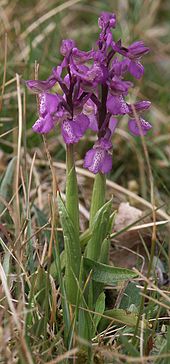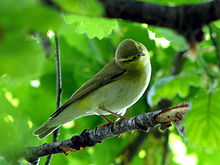Kohlersloch
|
Kohlersloch nature reserve
|
||
| location | Elzach , Emmendingen district , Baden-Württemberg , Germany | |
| surface | 18.2 ha | |
| Identifier | 3.234 | |
| WDPA ID | 164187 | |
| Geographical location | 48 ° 13 ' N , 8 ° 8' E | |
|
|
||
| Sea level | from 440 m to 640 m | |
| Setup date | April 8, 1997 | |
| administration | Regional council Freiburg | |
Kohler hole is a nature reserve in the natural area Central Black Forest in Baden-Wuerttemberg .
geography
The nature reserve is located in the area of the city of Elzach and the Oberprechtal district in the district of Emmendingen . It is located west-southwest about 1.2 kilometers as the crow flies from the village of Oberprechtal. It lies to the east below the Holzerkopf and above the state road L 107. It is steeply aligned on a mountain slope and exposed to the south.
Characteristics
The area was designated as a nature reserve by ordinance on April 8, 1997 and is listed under the protected area number 3.234 at the Freiburg Regional Council. It has an area of 18.2 hectares and is classified in IUCN Category IV, a biotope and species protection area. The WDPA ID is 164187 and corresponds to the European CDDA code and the EUNIS number.
The main protection purpose “is the preservation of the area
- as a structure and species-rich mosaic of poor pastures, wetlands, bushes and different forest types,
- as a habitat for a large number of endangered animal and plant species, some of which are threatened with extinction,
- as an area with extensive pasture use. "
geology
The geological subsoil is gneiss ( syenite ).
Flora and fauna

The protected area consists of a structure and species-rich mosaic of grasslands , wet areas, bushes and different types of forest. The extensively grazed areas with various animal species such as cattle , sheep and probably also goats already have a forest character that is reminiscent of the forest pastures that were common in the past and is now only rare. It is therefore the habitat of a large number of endangered and in some cases endangered plant and animal species.
flora
The poor grasslands distributed in the area are differently developed, mostly nebulas . They are the habitat for the hawkweed , the broad-leaved thyme , the bloodroot and for the dog violet as a common indicator of thinness. In addition, there are the silver thistle , the golden thistle and the creeping grouse as warmth-loving and base-rich soils indicating species . In addition to the bristle grass from the family of the sweet grasses as another type of grass still is three tooth striking the juniper comes sporadically.
From the family of the endangered orchids , the autumn rootwort is to be mentioned, it is represented in good numbers on a cattle pasture in the northern area, as well as the orchid , which blooms in spring . The male orchid is also represented in the area.
In shallow and sometimes disturbed areas, the carnation family grows the perennial ball , the bellflower family the perennial sandbell and the cruciferous family the rare bare-stemmed mustard , which sometimes occurs in high concentrations.

In the past, individual areas in the central Black Forest were regularly burned down by the Reutbergwirtschaft , which encouraged the settlement of the broom . As a remnant, the poor pastures are still interspersed with broom in some areas. Blackberries , soft honeydew grass and sage germander are found in these pastures . The heather and blueberry dominate in some places on extensively grazed areas.
In the more humid areas of the pastures with spring water outlet and channels, there are mostly small sedge-rich formations of silicate - rush - meadows and small areas of flat bogs ( swamp heart leaf - brown sedge swamp ). A number of rare and endangered species have their habitat here, such as B. the broad-leaved orchid as another orchid, the forest louse weed , the yellow sedges , the narrow-leaved cottongrass , the bog bedstraw , the bristly scaled ledge , the rush , the heart leaf , the swamp violet , the fever clover and increases the Flutter rush in more disturbed places.

Forest and pastureland merge into one another in the area, there are similarities to the earlier forest pastures practiced in large areas with pastures reaching far into the woods. As a rule, structurally rich coppice-like plants grow on the areas that are still grazed .
The tree layer ( stratification ) in these areas is characterized by the pedunculate oak , the ash , the sycamore maple , the bird cherry , the hornbeam and the silver birch , which vary in their stock over small areas.
The shrub layer is diversely developed and consists of the hazel , the single hawthorn , the dog rose , the buckthorn , the broom and the holly . The numerous swellings of the black alder , which dominates in the western part of the area in a hollow on a slope, indicate (former) coppice forest management.
The herbaceous layer shows through a farnreiche structure fresh to moist site conditions and consists of the ordinary Dornfarn , the masculine male fern, the forest Frauenfarn , the wood sorrel , the Red thimble and the mountain prize .
fauna

Many bird species benefit from the rich structure of the area and especially the small area alternation between wooded, bushy and open areas. Fitis should be mentioned as a representative . Among many other birds, the black woodpecker , the wood warbler and the golden cockerel have their habitat in forest areas.
Among the insects there are some notable species of grasshoppers such as B. the potbellied grasshopper . As a heat-loving species, it prefers places with little vegetation near the edges of forests or bushes. The meadow grasshopper and the marsh grasshopper are endangered in their species and can be found on pastures and wet meadows.
Ants find ideal living conditions in the area on the extensively used pastures, including the warmth and drought-loving black gland ant ( Tapinoma erraticum ) and the twin species ( Tapinoma ambiguum ). They were found particularly frequently on the broom. The red wood ant finds its habitat in warm and dry coniferous and mixed forests .
The beetle species from the black weevil group that are endangered in Baden-Württemberg live almost exclusively on the broom broom.
hike
The famous long-distance hiking trail Black Forest-Querweg Rottweil-Lahr and the Zweälersteig run along above the area . At the signpost and wayside cross Lehrscheide ( 618 m above sea level ), a path leads south-west down into the protected area.
See also
- List of nature reserves in Baden-Württemberg
- List of nature reserves in the district of Emmendingen
- List of natural spatial units in Baden-Württemberg
Individual evidence
- ↑ Profile of the nature reserve in the LUBW's list of protected areas
- ↑ Map services of the Federal Agency for Nature Conservation ( information )
- ↑ § 3 Protection purpose ordinance of the Freiburg Regional Council of April 8, 1997, accessed on November 11, 2014.
- ↑ Appreciation of the protected area , accessed on April 2, 2013
literature
- Nature Conservation and Landscape Management Unit: Nature reserves in the Freiburg administrative region . Ed .: Regional Council Freiburg. 3. Edition. Thorbecke, Ostfildern 2011, ISBN 978-3-7995-5177-9 .
Web links
- Profile of the nature reserve in the LUBW's list of protected areas


